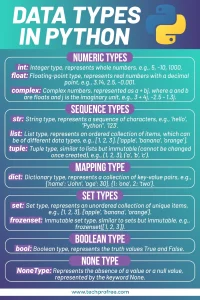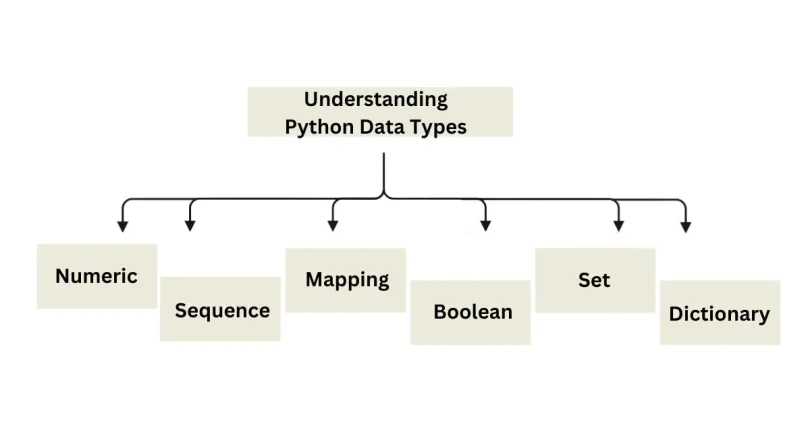Learning about data types in Python is one of the broad-spectrum concepts of programming because they help in understanding the nature and volume of the data being worked on, as well as the functions connected with them. Every developer necessitates to comprehend Python data types for efficiency in producing accurate code. Understanding these data types improves coding effectiveness because the selected data type determines the possible values and operations on the selected data type.
This article will give an all-embracing description of the various data types in Python.
What are Python Data Types?
Python has several built-in types, numerics, classes, libraries and exceptions, and more specific types like date and time, double-ended queues, and fixed-type arrays. The data types sort data items based on their attributes and format, which facilitates computer systems data analysis.
The primary data types commonly encountered in Python include:
- Numeric
- Sequence Type
- Mapping
- Boolean
- Set
- Dictionary
Python Data Types
Data types in Python can be described as groupings of data items which determine the nature of the value stored in a variable together with acceptable operations. In Python, all entities are treated as objects. Data types are represented as classes, with variables acting as instances of these classes.
- Numeric Types: int, float, complex
- Sequence Types: str (string), list, tuple
- Mapping Type: dict
- Boolean: bool
- Set Types: set, frozenset
- Binary Types: bytes, bytearray, memoryview
1. Numeric Data Types in Python
These data types signify precise numbers, integer, floating numbers, or complex or imaginary numbers.
These are implemented through the classes; int, float and complex…
- Integers: Integers are whole numbers, which can be either positive or negative, and do not contain any decimal places. These numbers are represented by the int class in Python. Python allows integers to have any length, with no fixed size limit.
- Floating-Point Numbers: These include real numbers local float class, which are float numbers that contain decimal points or are in the scientific notation form such as 1.23 or 4.5e3 respectively.
- Complex Numbers: These numbers are complex classes represented where the number is of the form (real) + (imaginary)j where real and imaginary are integers, eg 2+3j.
2. Sequence Data Types in Python
Sequence data types are used to store and arrange groups of values. These types consist of:
- Text Sequence Type: str (string)
- Sequence Types: list, tuple, range
- Binary Sequence Types: bytes, bytearray, memoryview
Strings
These are Unicode characters in Python and are made of strings. They are enclosed in single (‘), double (”), or triple quotes (‘’’), and indexing (both positive and negative) enables one to get a particular character.
Lists
Lists are changeable collections that gather similar information. They can have items of diverse types and their values can be changed (mutated) without affecting the list object. Lists are defined using square brackets and can hold multiple elements in a specific order.
Tuples
Tuples are sequenced or ordered collections of objects which are also non-modifiable. The one big difference worth mentioning is that the contents of a tuple cannot be changed, unlike the contents of a list. Commas define tuples and are optionally enclosed in parentheses (, 1, 2, 3).
3. Boolean Type in Python
It represents one of two built-in values. These are True or False. It is implemented using the bool class. It will be noticed that booleans are utilized to denote the truth values involved in logical formulas.
Truths and False Values: The value True should be assigned to objects that are considered truths while False to false objects. It is also important to note that a Non-Boolean object can also be coerced into Boolean context returning True or False depending on the object.
Creating Boolean Values: Booleans are created using the bool () function which transforms an expression or an object to its truth value.
4. Set Data Type
The set in python is one of the data types that is iterable and mutable, it does not contain any repeating members. The elements in a set are not stored in a specific order and the set may contain a mix of data types.
Creating a Set in Python
The use of sets can be done by placing the set () function which takes an iterable or sequence, or by using curly braces {} with elements separated by commas. A set can contain elements of any data type and will not allow for duplicate values to be entered.
Accessing Set Items
The elements of a set are not placed in any particular order, such that one cannot refer to the nth element of a set, as one would with an ordered list. But, you can use a for loop to loop the set, or to check whether an element exists in the set you can use the in keyword.
5. Dictionary Data Type in Python
The dictionary data type is an array of objects in Python common with a key and value. It is a way of organizing data whereby concerning a particular key, one can easily get another related value; it is somewhat like a map.
Some characteristics of the study involving dictionaries are as follows:
- In a dictionary, every key must be unique, while values can be repeated as many times as possible.
Keys in a dictionary are case-sensitive, meaning that keys with the same name but different capitalizations are treated as distinct.
Dictionary items are placed within curly braces {} and separated by commas, with each key-value pair linked by a colon :.
Dictionaries Creation and Access
A dictionary is formed by placing key-value pairs inside curly braces. To get the value of any key, you can do it directly by its key name or using the get() function.

Guidelines on the Use of Data Types
- Choose the Right Type: Choose one of these data types that fit your data’s structure and your requirements as much as possible.
- Leverage Mutability: Use a tuple for data that cannot be changed and a list for data that can be changed.
- Avoid Overhead: Prefer simple data types where performance is going to be at a premium.
- Use Type Hints: Attribute types to improve the readability and simplify the debugging of the given code.
Understanding the data types in Python will help programmers categorize data and work with it more efficiently and solve problems. This broad-encompassing kind of knowledge is crucial to code cleanly, thoughtfully and error-free.
Importance of Data Types
- Memory Optimization: Data types are important to avoid wasting memory by using the wrong type of data for a particular task.
- Error Prevention: Proper use of data types reduces the probability or likelihood of runtime errors and logic mistakes.
- Enhanced Code Readability: The careful choice of data types enhances writing, clean, extensible and concise code.
- Efficient Computations: Applying the right data types can enhance the execution of computationally demanding operations in various data-reliant applications.
Final Discussion
Understanding the essentials of Python data types is one of the most significant foundations for programming, which allows to reveal the potential of the language. Moving beyond the simple definitions, the Boolean, Integer, Float/Decimal, String, List, Tuple, Set, and Dictionary data types are the main architecture of the data that is available to the Python programmer to store, sort, search, and process data most appropriately to achieve high speed, little memory use, and good code.
Regardless of whether you are using mutable lists, immutable tuples or dynamic dictionaries, these data structures define the range and speed of operations in your programs. Hence, by embracing these lessons, developers can learn how to build performant, extensible, and sustainable solutions that solve unique demands in various technologies and data-driven systems.
This article provides insights into the data types available in Python and how they can be used in practice so that developers not only know what tools they are using but also can advance and lead in their fields. With Python as a language rising in popularity, it is not only important to understand the foundations of the language, but crucial for mastering modern software development.
FAQs
Lists for their part are changeable or modifiable after they are defined, for tuples, this is not the case. Loops Operating in lists take more time than tuples which operate in the least time. Lists are slightly larger in memory than tuples.
A set in Python is a collection of distinct elements that do not have a specific order. It is iterable, mutable, and does not allow duplicates. Example:
my_set = {1, 2, 3, 4}
This format makes it easy to read and serves as a quick reference for Python learners.
A tuple is a collection of ordered elements, much like a list. Tuples are typically created with parentheses, and their items are divided by commas. Example:
my_tuple = (1, “Python”, 3.14)
A Python array stores elements of the same type, which makes it more memory-efficient. A Python list can hold elements of mixed types and is more versatile but uses more memory.
A Python list is a dynamic-sized array that stores an ordered collection of items. Lists can hold items of mixed types, including other lists. Example:
my_list = [1, “Python”, 3.14, [5, 6]]
A string is a series of characters surrounded by quotation marks, which can be either single, double, or triple quotes. For example:
s = “Hello, Python!”
Python supports three types of numeric data:
Integers: Whole numbers (e.g., a = 4)
Floating-point numbers: Real numbers with fractional parts (for example, b = 4, 5).
Complex numbers
It is defined by assigning a variable either the value True or False. For example:
is_valid = True
is_active = False
You can also use expressions that evaluate to a boolean value:
result = 10 > 5 # result will be True




Leave a Comment